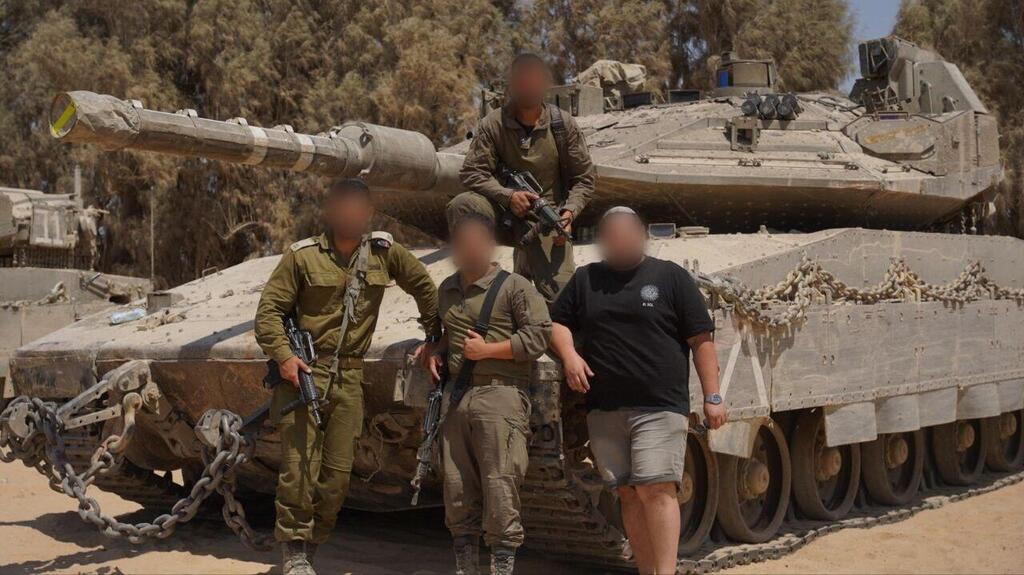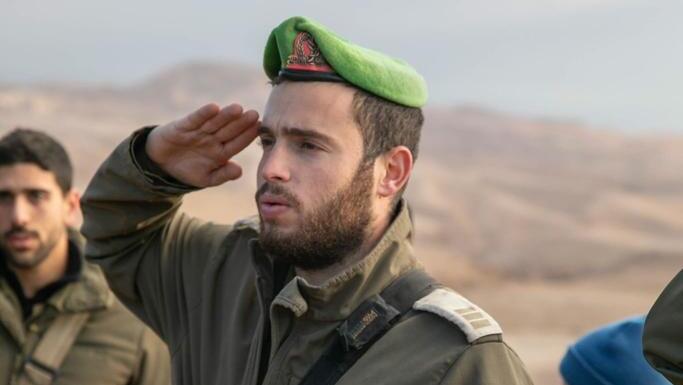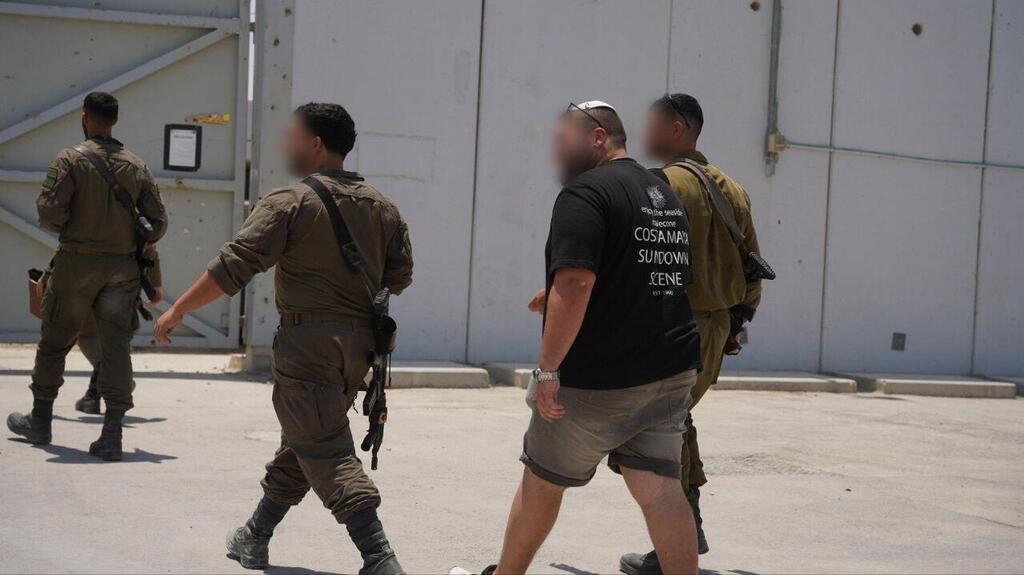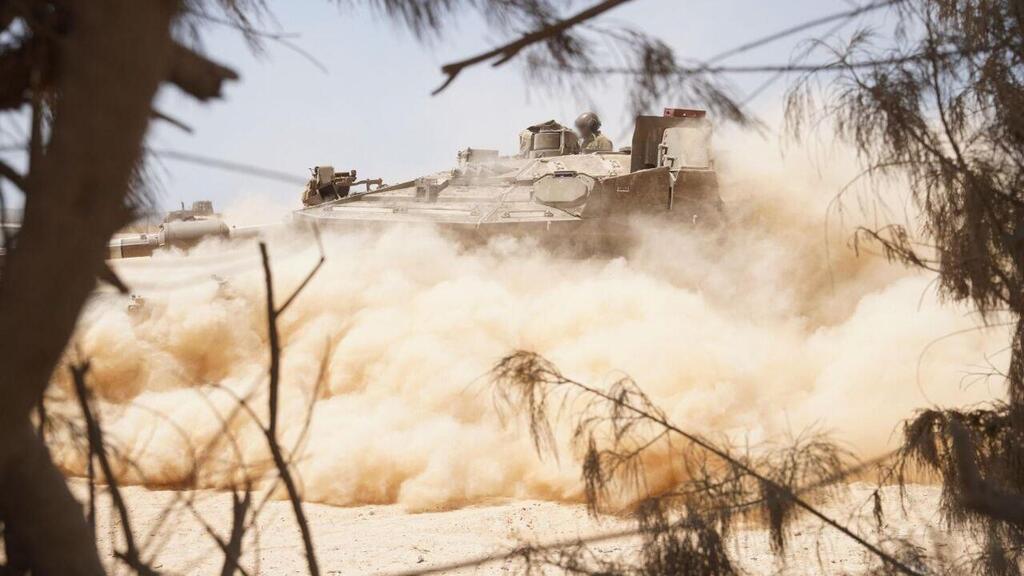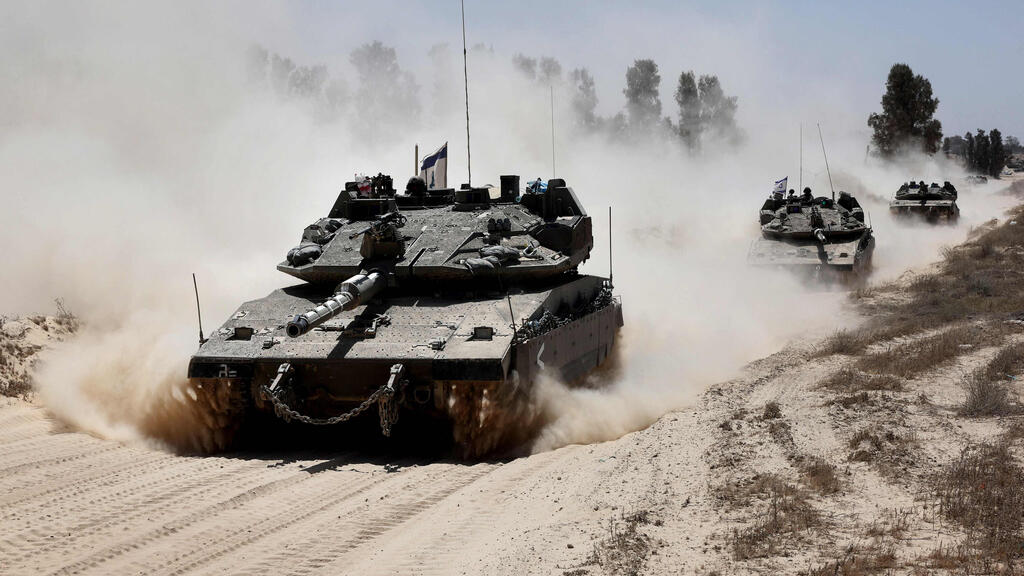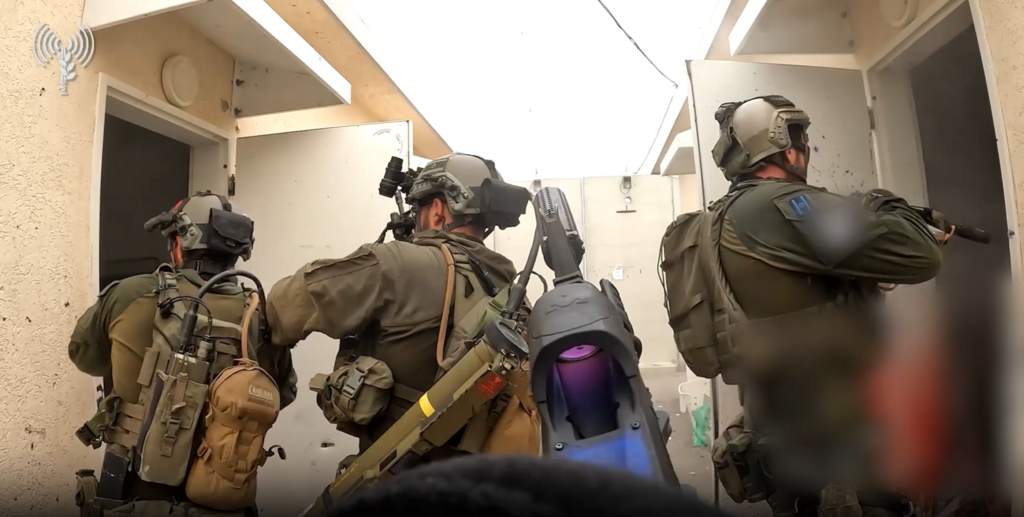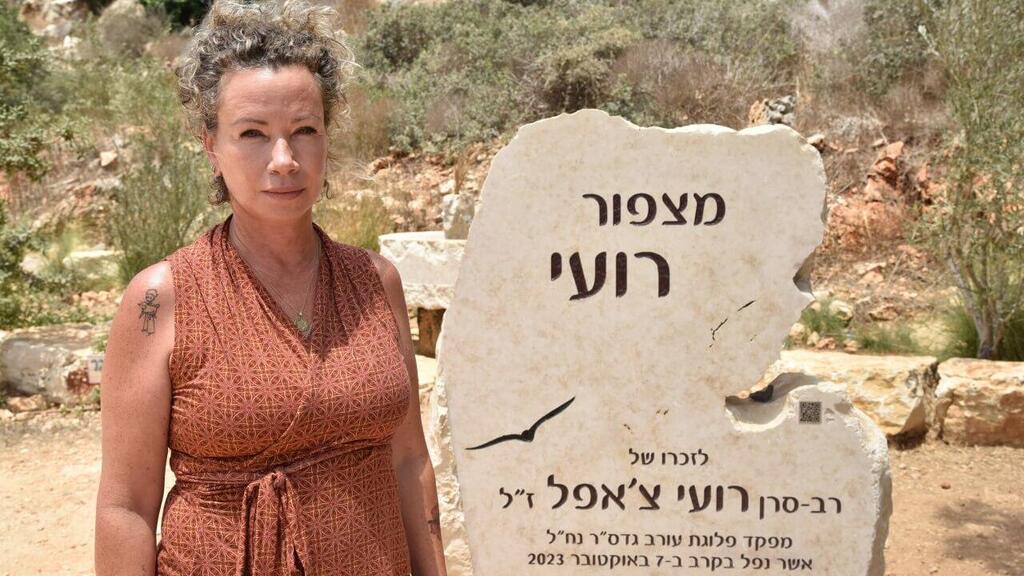On the morning when the skies fell, the voice of Maj. Roey Chapell was an island of stability. Amid relentless rocket and mortar fire, as hordes of armed terrorists charged toward the western Negev in convoys of pickup trucks and motorcycles, the commander of the Nahal Reconnaissance “Orev” Company embodied the elusive concept of “commander’s spirit” over the radio.
Months into the war, his mother, Orit Tzuk, received audio recordings of Roey’s final communications. “I already know the orders he gave by heart,” she said. At 6:37 a.m., in a calm and authoritative voice, Roey was heard instructing the lone tank crew in his sector: “Four, this is the command. We have an armed infiltration. You’re cleared to fire on anything you identify. This is a complex situation. You’re the target, no one else.” Thirty-three minutes later, at 7:10, Roey was killed.
Footage of the tanking holding off Hamas terrorists on October 7
(Video: IDF)
“His radioman, who was severely wounded, grabbed the radio and reported, ‘Roey has fallen,’” recalled Lt. A., then a tank platoon commander with the 77th Battalion’s Vulcan Company. “We all heard it inside the tank. No one spoke. We kept fighting—just like Roey instructed.”
At that same moment, in her home in Zichron Yaakov, Orit awoke with a jolt. “I didn’t yet know about the Hamas surprise terror attack,” she said, “but I felt something had happened to Roey. I picked up my phone, saw the headlines, and I knew—Roey was gone.”
Lt. A’s platoon, consisting of three tanks, was under Roey’s command, holding the sector near the kibbutzim of Sufa, Holit, and Nir Yitzhak. On Simchat Torah, only one tank crew remained on alert—A’s. The others had gone home. The Nahal Recon's command staff was also operating at minimum capacity. With just a handful of soldiers at the Sufa outpost, a mortar team from the 50th Battalion, and that lone tank crew—whose actions will be etched in history—Roey and his men tried to halt the onslaught of Hamas’ Nukhba fighters on that Saturday morning.
In the early hours of the assault, the entire command chain collapsed: Company commander Roey Chapell and his deputy, Maj. Ido Israel Shani were killed in the initial fighting. Reconnaissance Battalion Commander Lt. Col. Yehonatan Tzor and Nahal Brigade Commander Col. Jonathan Steinberg also fell in gun battles. Southern Brigade Commander Col. Asaf Hamami was killed in Kibbutz Nirim; his body was taken to Gaza.
With no commanding officers left, no reinforcements arriving until noon, and no one to consult, Lt. A. found himself alone—but with a tank crew he could trust with his life. I met them this week along the border fence near the Sufa outpost, where they fought for three and a half hours under anti-tank fire and explosive drone attacks, firing, ducking, reloading, and firing again. They fired 38 shells and thousands of machine-gun rounds until their ammo nearly ran out. The outcome: over 100 Hamas terrorists killed in their sector, and countless others retreated before even crossing the fence, perhaps believing they were facing a full tank company.
Three of the crew members are still in active service: Lt. A from Ashdod, the commander; Sgt. B from Metula, the driver; and Sgt. N from Tel Aviv, the gunner. Their former loader, Sgt. (res.) A, from the moshav Tifrah near Ofakim, joined the interview in civilian clothes. Explosions echoed nearby—airstrikes and artillery. “Nice one!” A quipped after one loud boom.
On the morning of October 7, they were stationed at the Sufa outpost, just a few hundred meters away. “We’d been on the line for three months—we knew the terrain, the procedures, and each of us knew our role perfectly,” said Lt. A. “At 5:30 a.m., we were already at the tanks, on dawn alert. We were sitting in a little shack we had when we suddenly heard rockets whistling and exploding directly above us. Within seconds, we jumped into the tank and drove to the ridge you see there.”
The ride took three minutes but felt like an eternity. “We drove on the armored vehicle path—it’s full of potholes,” B recalled. “I floored the gas. The guys in the back got their heads knocked against the turret. But I still had in my head: If I damaged the road, the company commander would kill me. Rockets or not, we’re not overdoing it.”
They didn’t yet realize the rocket barrage was just a diversion for the massive ground assault. “We thought we’d reach the position, fire two warning shots, and head back,” said N, the gunner. Once outside the outpost, A ordered the hatches closed. “That saved us,” said B. “I slowed so they could load a shell, and two seconds later I saw an explosion just meters in front of us.” It was a drone with an explosive head. Because they slowed down, it hit the ground in front of the tank. Another drone dropped a grenade directly onto the closed hatch. “If it had entered the turret, we wouldn’t be here,” said B.
Despite it all, they reached the position and fired their first shell—at an empty Hamas position from their target bank. “It was the first real shell we fired in combat,” said N. “Felt like we were launching a rocket to the moon,” B added.
Then Roey came over the radio: “Go up to the position. Tell me what you see. I’ll clear you to fire.” They scanned the fence and spotted a white pickup truck trying to breach it. N zoomed in and fired. “Blew it up,” he said. “Then I shifted slightly and saw a convoy of four pickups, motorcycles, and men sprinting. I realized instantly—they were terrorists.”
“We were under fire from dozens of terrorists,” said B. “We understood we couldn’t stay exposed. My job was to minimize how long the tank was visible. I’d stop mid-slope, they’d load, we’d fire, and I’d drive back down. One second too long—and you get hit. And we did.”
An anti-tank missile hit their engine. From that point on, B had to use emergency gear. “Three and a half hours: up-fire-down, again and again. No rest. A loading shells like mad, N shooting, A commanding. Four of us became like one person,” he said.
“When the missile hit, smoke filled the turret. A and I looked at each other like, ‘You alive? I’m alive? Keep going,’” said A. “From the moment we reached the ridge, no terrorist crossed the line. Everyone we saw—dead.”
While they held the line in their sector, terrorists breached others and reached area kibbutzim. The toll was devastating: 13 were murdered in Holit, seven in Nir Yitzhak (with four abducted), and three in Sufa. But Roey’s Orev Company and A’s tank crew prevented a massacre on the scale of Be’eri, Kfar Aza, or Nir Oz.
At some point, the tank crew heard on the radio that terrorists had taken the Sufa outpost. With Roey gone, Orev fighters were trapped in the dining hall, now a makeshift shelter, surrounded by 60 Hamas terrorists. A faced a dilemma—stay at the fence or return to help?
Just then, a pause in the fighting gave them the chance. The convoys stopped. After consulting his team, A decided to head back.
They drove through the fields under tank smoke cover. “I saw irrigation pipes flying,” said B. “I whispered an apology to the farmer whose field I was plowing.” At the outpost entrance: white trucks, a mass of motorcycles, and a sobbing soldier over the radio: “They’re here, we have nothing, help us.” Echoes of voices from 50 years earlier—October 6, 1973.
“For us, it was a hostage situation,” said B. “They were trapped in the dining hall—whoever went out was shot. I’m a tank, I don’t know who’s where. I didn’t want to shoot a room and hit our guys. We figured the trucks were waiting to take bodies or hostages to Gaza. We said, ‘No one in, no one out.’ We patrolled around the outpost and killed several terrorists.”
Get the Ynetnews app on your smartphone: Google Play: https://bit.ly/4eJ37pE | Apple App Store: https://bit.ly/3ZL7iNv
By early afternoon, reinforcements arrived. Caracal Battalion commander Lt. Col. A took over the sector. At 2 p.m., the elite navy unit Shayetet 13 forces arrived. “We picked up the rear phone, ‘Hey, what’s up? We’re here to rescue the outpost,’” said N. A got off the tank to meet them. “They told me, ‘Whatever happens, you go in first. We’re behind you.’ I said, ‘Fine, we’re in.’ Gave them confidence.”
Shayetet 13 forces at the Sufa outpost
(Video: IDF)
B added, “I rolled in a few meters and saw this huge terrorist with a Kalashnikov, stunned. He didn’t expect a tank. Other terrorists were lounging inside the outpost like it was theirs. I backed out, we regrouped, and stormed in with the Shayetet on our sides.” Two hours of combat later—caught on body cams—the outpost was retaken.
But it wasn’t just tanks and commandos that saved the soldiers. It was Roey’s quick thinking, too. “At dawn, Roey was outside with his HQ team,” said his mother. “He called a junior officer at the outpost and told him to get everyone in full gear—terrorists were coming. That officer came to the funeral on crutches, leaned on me, and said, ‘Roey saved us.’ That one instruction allowed them to gear up, arm themselves, and hold out.” The soldiers fought from the dining hall for eight hours, holding off dozens of terrorists.
In his last 40 minutes, Roey made a series of decisions that saved lives. He was killed trying to rescue another recon team trapped at the Dangur memorial, surrounded by dozens of terrorists. His radioman, Tomer Yaakov Mizrahi of Hoshaya, also fell. Their driver, Roni, was severely wounded and lost a leg. But they managed to kill dozens of terrorists in that battle.
Roey, a graduate of the Haifa military academy, was 25. In April, his grandmother, Hedva Tzuk, suffered a stroke while watching a TV report about the battle—a segment aired without IDF coordination. She died 12 hours later.
Lt. A’s tank platoon has since fought in Gaza, Lebanon, and Syria. “From the outpost in Lebanon, I could see my house in Metula,” said B. His family had been evacuated for over a year. But the three and a half hours on the Gaza border, facing endless waves of terrorists, were, the soldiers said, the most meaningful of their lives.




